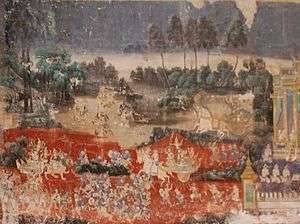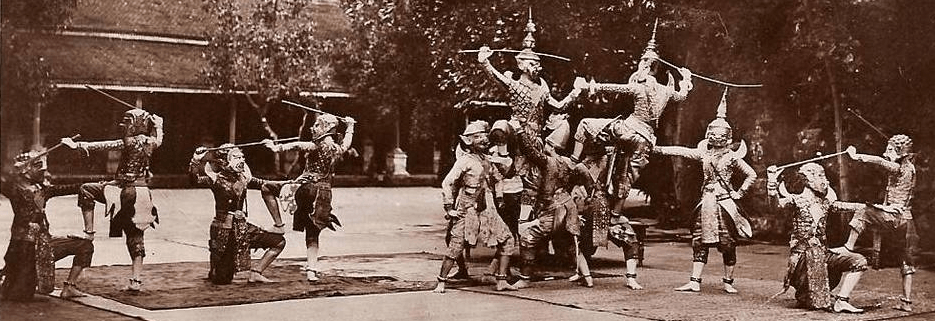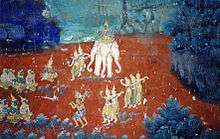Reamker

Reamker (Khmer: រាមកេរ្តិ៍ [riːəmkeː], also romanized as Ramakerti) is a Cambodian epic poem, based on the Sanskrit's Ramayana epic. The name means "Glory of Rama". It adapts the Hindu ideas to Buddhist themes and shows the balance of good and evil in the world. More than just a reordering of the epic tale, the Reamker is a mainstay of the royal ballet's repertoire. Like the Ramayana, it is a philosophical allegory, exploring the ideals of justice and fidelity as embodied by the protagonists, Prince Rama and Queen Sita. The epic is well known among the Khmer people for its portrayal in Khmer dance theatre, called the L'khaon, in various festivals across Cambodia. Scenes from the Reamker are painted on the walls of the Royal Palace in Khmer style, and its predecessor is carved into the walls of the Angkor Wat and Banteay Srei temples. It is considered an integral part of Cambodian culture.
The Reamker differs from the original Ramayana in some ways, featuring additional scenes and emphasis on Hanuman and Sovanna Maccha.
In the Reamker, issues of trust, loyalty, love, and revenge play out in dramatic encounters among princes and giants, monkeys and mermaids, and a forlorn princess. Though it is understood that Preah Ream is an incarnation of the Hindu god Vishnu, his characteristics and those of the others in the story are interpreted in Cambodia as those of mere mortals, not of the gods as is the case in India. The complex interplay of strengths and weaknesses, though couched in episodes lined with magic, nonetheless represents a decidedly human social behavior.
As in other Southeast Asian countries, the Rama story in Cambodia is not confined to the realm of literature but extends to all Cambodian art forms, from sculpture to dance drama, painting and art. Another epic, Lpoek Angkor Vat (“The Story of Angkor Wat”), which dates from the beginning of the 17th century, celebrates the magnificent temple complex at Angkor and describes the bas-reliefs in the temple galleries that portray the Rama story.
History

The original Ramayana arrived to Southeast Asia from South India along with Hinduism, but its retelling there suggests Buddhist influence. Intricate carvings on the walls of Angkor Wat depict a scene from the Ramayana dating back nearly a millennium. Statues of the poem's heroes were worshiped in temple sanctuaries, akin to the wall paintings at Cambodia's Royal Palace and Wat Bo. The Ramayana has been an important epic in India for at least two thousand years, and Reamker is its Khmer adaptation. The Cambodian version includes incidents and details not found in the Sanskrit original written by the poet Valmiki. An example of a story that does not appear in Indian texts and performance is that of the encounter between Hanuman, the monkey general, and Sovanna Maccha, the mermaid, a favorite of Cambodian audiences.[1]
Central plot

The Reamker plot begins with its protagonist, Phreah Ream or Rama, being sent into exile by one of the queen mothers who wanted her own son to inherit the throne. After being sent to the forest, Phreah Ram is joined by his beautiful and faithful wife Neang Seda (Sita), whom the prince won in a fighting contest. Praeh Leak (Lakshmana), the younger brother of Phreah Ream, is concerned about his older brother and joins Neang Seda. [2]
While entering the forest, Neang Seda and Preah Leak meet the rakshasi Surpanakhar (Surphanakha) who first attempts to seduce Preah Ream, and then Preah Leak. Preah Leak, annoyed by the demon's action, cuts off her ear and nose. The butchered Surpanakhar thirsting for revenge went to her ten-headed brother Krong Reap (Ravana), invincible lord of the island of Lanka. Krong Reap secretly goes to the forest. When he first set eyes on Neang Seda, he was awed by her divine beauty. Having tricked Preah Ream and Preah Leak with a ruse, he disguises himself as an old errant and kidnaps Neang Seda. Preah Ream and Preah Leak desperately search for Neang Seda and, in the meantime, they assist the monkey king Sukreep (Sugriva) to destroy his rival Pali Thirat (Vali) and regain his throne. Thanking the two, Sukreep sends the monkey warrior Hanuman to aid them in their search. Hanuman, the son of the wind god, flies out to discover that the demon Krong Reap held Neang Seda prisoner on the island of Lanka.[3]
Hanuman order his soldiers to build a bridge of stone to connect the island Lanka to the mainland. While gathering stones, Hanuman realizes that mermaids were stealing stones to prevent the construction of the bridge. He was roused by this and decides to capture the mermaid princess Neang Machha but falls deeply in love with her. The mermaid likewise falls in love, and thus her mermaid army ceases to tamper in Hanuman's business. The bridge built, Preah Ream and Krong Reap face each other in combat and, with Hanuman's aid, slay the demon. Preah Ream, victorious in his battles, returns to the capital of Ayuthya and ascends the throne. Trust issues between him and his wife Neang Seda are settled when she passes the trial of fire to prove she is still pure. Afterwards, people began to speak out against the queen and she must find refuge with Valmiki the wiseman, where she gives birth to twin boys. They met their father and he immediately recognizes who they are and takes them to his palace, he agrees to have Neang Seda by his side once more only if she passes another trial. Neang Seda summons the goddess of earth to testify her chastity, and ultimately passes.[4]
Characters
Humans
- Rama, known as Preah Ream [preəh riːəm], is the main protagonist of the epic. He is believed to be the reincarnation of the Hinduism deity Vishnu and the husband of Neang Seda and the father of his two boys.
- Sita, known as Neang Seda [niːəɳ seːda], the female protagonist of the epic and wife of Preah Ream. She gives birth to his two children, but fails to meet happiness at the end of the story. In the epic, she endured the trial of fire.
- Lakshmana, known as Preah Leak [preəh leək], is the brother of Preah Ream and his aid to fight Krong Reap and rescue Neang Seda.
Mythical beings
- Ravana, known as Krong Reap [kroɳ riːəp] or simply Reap [riːəp], is the main antagonist of the story. He is the brother of Sopphanakha and captured the beautiful Neang Seda to his island of Langka.
- Hanuman, pronounced as [haʔnomaːn], is the Monkey Warrior who helps rescues Neang Seda. While building the bridge connecting the island of Langka to the mainland, he fell madly in love with the mermaid Princess Sovanna Maccha.
- Sovanna Maccha, known as Neang Maccha, is a mermaid princess who tried to spoil Hanuman's plans to build a bridge to Langka but fell in love with him instead and bears his son Mudchanu
- Sugriva is the Monkey King who sent Hanuman to assist Preah Ream.
- Surpanakhar is the sister of Krong Reap. She failed to seduce Preah Leak and loses her ear and nose as a consequence.
See also
- Ramayana
- Ramakien
- Phra Lak Phra Lam
- Hikayat Seri Rama
- Khmer classical dance
- Dance of Cambodia
- Culture of Cambodia
- Greater India
- Kakawin Ramayana
External links
- រឿងរាមកេរ្តិ៍ខ្មែរ និងរ៉ាមគៀនថៃ
- The Reamker — Toni Shapiro-Phim
- Reamker
- The Treasures of Angkor ISBN 88-544-0117-X
- The Reamker
References
- ↑ Le Reamker - Description of Ream Ker in French
- ↑ The Reamker - an article by Toni Shapiro
- ↑ Reamker Epic Legend - a forum post
- ↑ Reamker - extensive site on the Reamker
.jpg)